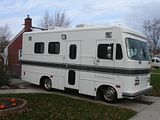Page 1 2
Go to...  | Start A New Topic  | Search  | Notify  | Tools  | Reply To This Topic  |  |
 |
The cycles of the cylinders are the same as a conventional internal cumbustion engine (intake, compression, fire, exhaust) but they are situated around a central shaft. The idea is if you need more power, you add another engine in front of (or behind) the first one spinning the same shaft. | |||
|
Similar to Wankel. #1 29' 1977parted out and still alive in Barths all over the USA | ||||
|
| The Old Man and No Barth |
In 1954, while I was a student at Denver University, an engineering major who lived across from me in the veterans' shanty town (almost every campus had one post WW II) showed me drawings of an engine similar to the Jones engine. The method of operation, as with the Jones engine, was not readily apparent, & he was cagey about that aspect. I wonder if, over 56 years, an operating engine has actually been built to prove the concept. One would think by now, if the concept is feasible, we would have a practical application. It's tough to bring any invention to market unless it has clear advantages over what exists. One of my son's friends spent a fortune developing and marketing a kitchen faucet that is controlled by leaning against a bar in front of the sink. The ostensible advantage is hands-free operation. Going from an apparently simple concept to something that works reliably, and can be mass-produced, proved extremely difficult. No manufacturers were interested because the technology is more complex than what exists, & the single outstanding advantage was not enough to warrant the capital costs involved in manufacturing & mass-marketing it. Rotary aircraft engines, a la LeRhone & the German Oberursel copy, have gone the way of the dodo bird. They were an experiment in the development of internal combustion engines in which the disadvantages ultimately outweighed the advantages. All I know about WW I aircraft & engines, I learned from reading "Dare Devil Aces," "Flying Aces," & other pulp fiction, as a kid in the '30s. | |||
|
| First Month Member |
Yeah, its too bad none of the previous rotary engined motorcycles never worked out. I think Norton was the last one. The Jones engine would be neat for ultralights, too. . 84 30T PeeThirty-Something, 502 powered | |||
|
| First Month Member |
My own take on that is that foot pedal hot and cold faucet controls already exist. Our mop sinks at work had them. Simple and reliable. Volume and temp could be controlled with just the toe of one shoe. And, again, I cannot take credit for the Dark Sucker thing. It has been around since I was in college, or Army tech school. I did color it up a bit, but my contribution is minimal. . 84 30T PeeThirty-Something, 502 powered | |||
|
| 1st month member |
Suzuki tried a Wankel rotary 500cc in 1975 and it almost bankrupted the company. You can check it out on Jay Leno's garage. http://www.jaylenosgarage.com/...les/1975-suzuki-re5/ 1999 Airstream Safari 25' 2007 Toyota Tundra 1987 Yamaha YSR toads | |||
|
| Powered by Social Strata | Page 1 2 |
| Please Wait. Your request is being processed... |
|
This website is dedicated to the Barth Custom Coach, their owners and those who admire this American made, quality crafted, motor coach.
We are committed to the history, preservation and restoration of the Barth Custom Coach.
We are committed to the history, preservation and restoration of the Barth Custom Coach.